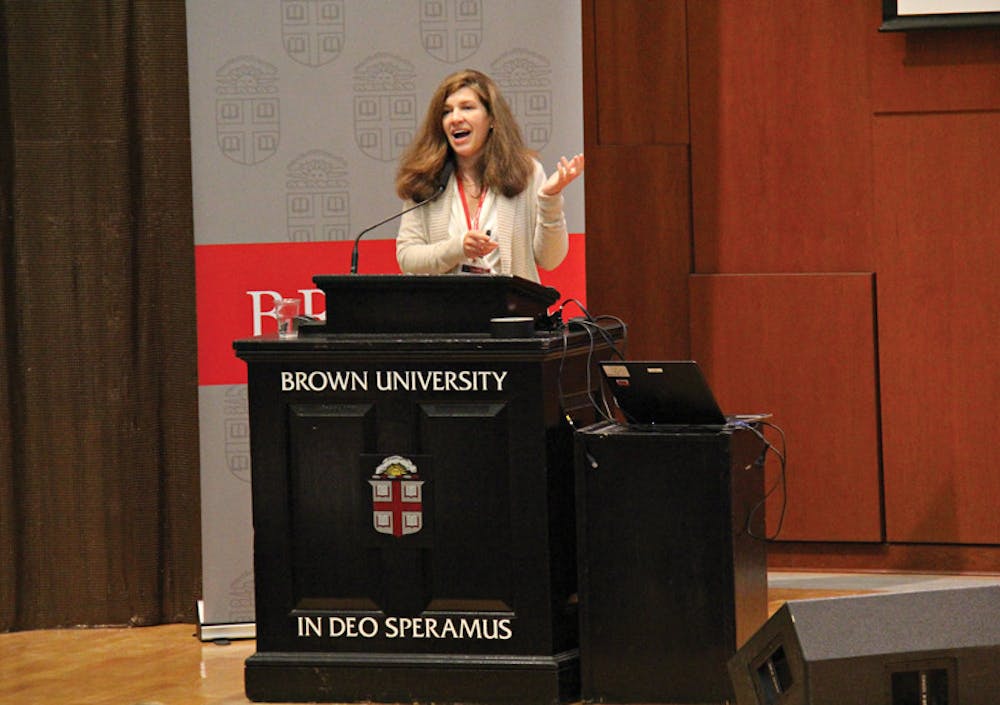The University’s Center for Alcohol and Addiction Studies celebrated its 30th anniversary amidst excitement about the center’s growth and concerns over future research funding at a colloquium Saturday in Salomon 101.
The colloquium featured a keynote address by speaker David Abrams, executive director of the Schroeder Institute for Tobacco Research and Policy Studies and professor at the Johns Hopkins Bloomberg School of Public Health, as well as 12 presentations by researchers followed by discussion panels.
President Christina Paxson and Peter Monti, director of the center and professor of alcohol and addiction studies, provided opening remarks.
When David Lewis, professor emeritus of community health, first opened the center in 1983, it was “simply a small office at Arnold Lab with a whopping budget of $1,500,” Paxson said at the start of the colloquium. But the center now employs 28 full-time faculty members and enjoys $13.3 million in grants for research, she said.
One of the center’s greatest accomplishments is its postdoctoral training program, Monti told The Herald. He added that the program trains more postdoctoral fellows than any other alcohol and addiction center in the country.
“I think one (important feature) is that we are a resource, for example, for people to come if they want to quit smoking,” said Professor and Chair of Behavior and Social Sciences Christopher Kahler. By participating in the center’s research studies, well over 1,000 people have gained access to the resources to quit, he added.
But the center’s ability to conduct research depends largely on grant money from the National Institutes of Health, Monti told The Herald and emphasized in his opening speech. “The biggest challenge we’re facing right now is the reduction of funding in the NIH,” Monti told The Herald.
Though the center gets “a larger piece of the funding pie with each passing year,” he said in his opening remarks, the size of that pie is diminishing. After sequestration went into effect in March, the NIH was forced to cut its annual budget by $1.55 billion. The reduction will be evenly spread across all programs and projects funded by the NIH, according to the NIH website.
The funds are necessary for the center to continue its work in encouraging young researchers to persist in tackling problems associated with alcohol and addiction, Monti said.
To introduce Abrams, Monti showed the audience a slideshow of photos of a shirtless male model who shares his name.
The real Abrams, who specializes in tobacco research, then took the stage, clothed, and discussed the history of the decline of cigarette use as well as the advent of electronic cigarettes. He said electronic cigarettes — advertised as a safer way to smoke than traditional cigarettes— will be mass-produced from several large factories in Europe.
Abrams said electronic cigarettes present a catch-22 to public health experts — promoting electronic cigarettes might enable current smokers to satisfy their cravings in a way that’s less harmful, but it might also encourage non-smokers to underestimate the risks of smoking.
“The one thing that our human brains don’t do very well is think about complex, long-term feedback loops,” he said, which causes many people to smoke for immediate gratification and disregard the long-term health risks associated with cigarette use.
Though smoking rates are at an all-time low in America — approximately 18 to 20 percent of adults smoke — the number of smokers has ceased to diminish, he said. Researchers in the field of addiction are attempting to analyze why certain people elect to smoke while others refuse to touch cigarettes, he said, adding that this information can help researchers determine how to reduce smoking rates.
Abrams said he has worked with new software that can track where individuals buy cigarettes. This type of individualized study can help researchers understand how one’s environment contributes to addictive behaviors.
Though Abrams focused on tobacco, other researchers who spoke at the colloquium covered topics ranging from environmental effects on teen alcohol use to the role of continual rehabilitation for individuals suffering from drug and alcohol addiction.
John McGeary, assistant professor of psychiatry and human behavior, discussed how analyzing genetic pathways could help clinicians discover personalized treatment methods for addiction, which some initial studies suggest have potential.
More than 70 people attended the symposium, including many faculty members and fellows of the School of Public Health as well as some of the center’s alums.

ADVERTISEMENT




